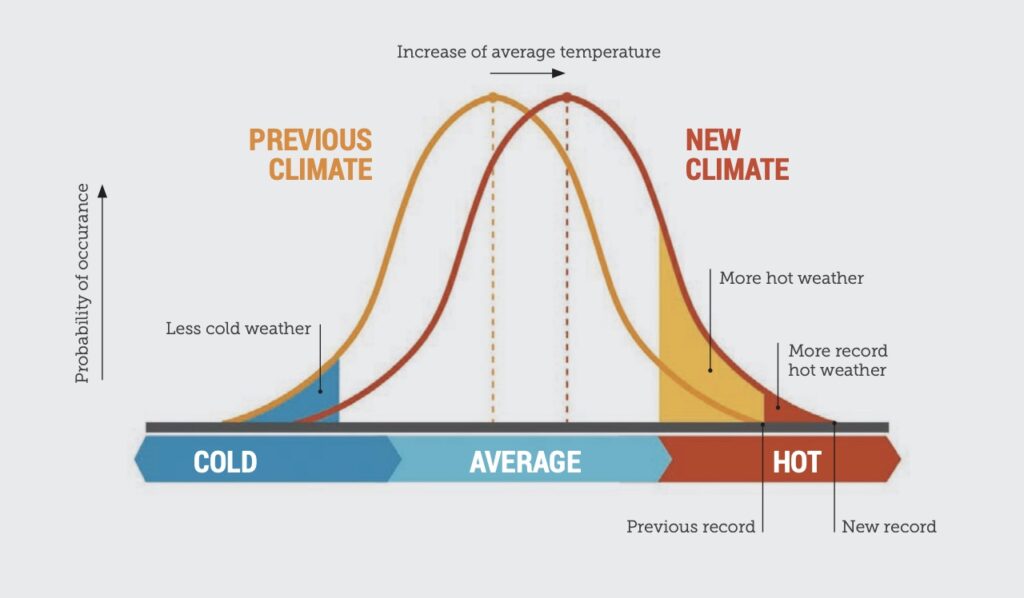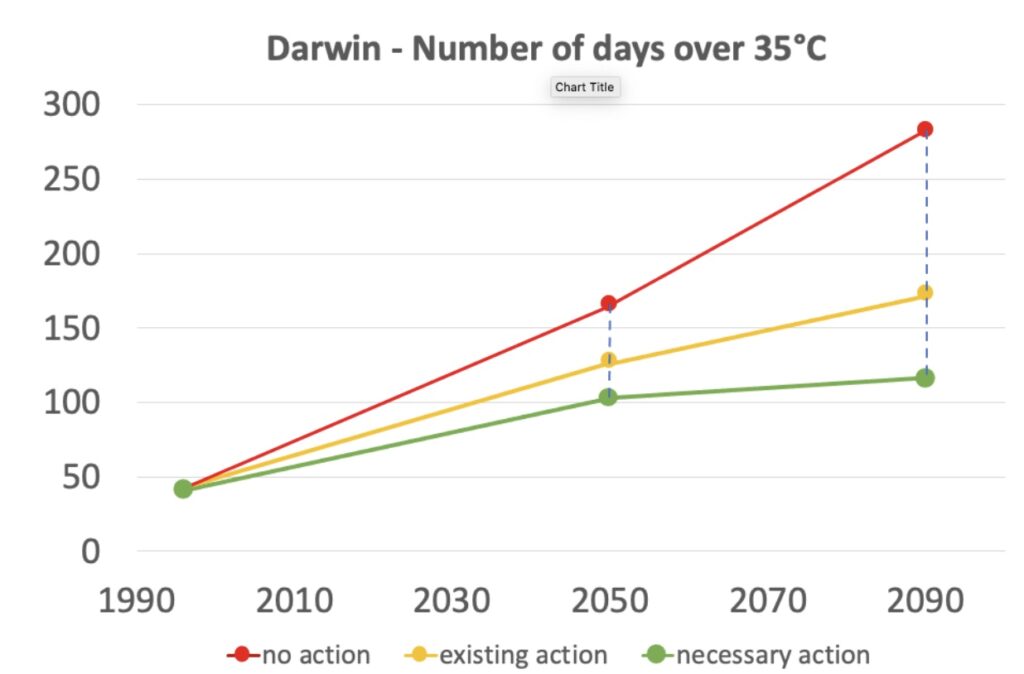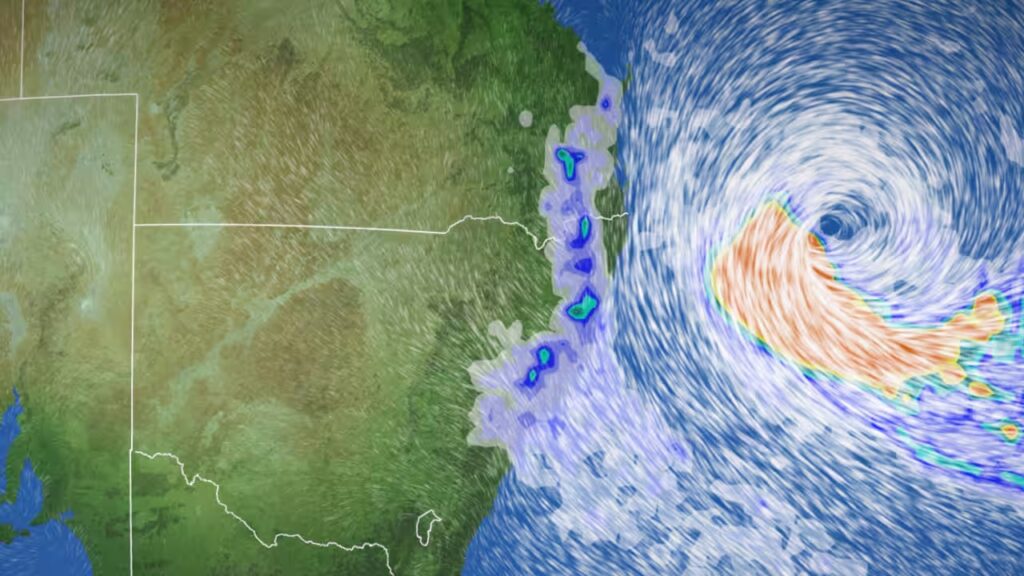Extreme heat is the most lethal consequence of climate change. Through stronger action to cut climate pollution right now, we can put the brakes on the heat that Australians alive today, and our children and grandchildren, will experience in future.
Here we take a closer look at some of the findings from our Climate Heat Map, and why every smart choice today will be measured in a brighter, safer future.
A small increase in average temperature makes a big difference
From remote communities in the centre of our continent to the sprawling outer suburbs of our capital cities, many Australians are already regularly exposed to extreme temperatures.
Australia has already warmed by around 1.5°C since 1910. While this may not sound like much, a small increase in the average temperature means we experience a substantial increase in the number of dangerously hot days. This can be easily grasped by looking at the figure below. When we increase the average temperature, days that were previously considered very warm will become much more common, and we will see temperature records broken much more frequently. At the same time, we will see fewer cool days and less reprieve from the heat.

The positive impact of our choices today will grow over time
While exploring our interactive Heat Map, you may find, when switching from ‘existing action’ to ‘necessary action’, that you only see a small decrease in the number of days over 35°C by 2050. The reason for this result is, due to our past climate pollution and a degree of inertia in the climate system, it takes a little bit of time for today’s choices to have a discernible effect on future temperatures.
However, the latest science suggests this lag is relatively short, and we will begin to see the positive effects of today’s actions well within our lifetimes. Furthermore, these positive effects will grow greater and greater over time. Taking the example of Darwin (below), we can see that the difference between ‘existing’ and ‘necessary’ action – that is, shifting from our current path to one of much faster cuts in climate pollution – becomes much bigger as we move further into the century.

Looking at the country as a whole, stronger action now could reduce the number of days above 35°C by around 20 percent by 2090. In other words, by the time a child born today is entering retirement, we will have substantially limited the amount of extreme heat to which they are exposed. And that effect will continue to grow, reverberating across many, many generations to come.
In a few cases, the Heat Map will show a small increase in the number of days above 35°C when you toggle from ‘existing action’ to ‘necessary action’. These occasional anomalies reflect the fact that each scenario is based on its own set of model runs. As explored above, while the effect grows considerably over time, the difference between the ‘existing’ and ‘necessary’ action scenarios in the expected number of hot days by 2050 is very small. With so many locations, and only a small difference in the overall outcome of these two scenarios, the models will inevitably produce the odd result that falls on the other side of what we’d expect. (We also see a few such anomalies in the results for 2090, as well as a small handful of inconsistent results caused by rounding up or down to the closest whole number of days). However, these do not challenge the overall picture – that stronger action today will substantially reduce the number of dangerously hot days that people will face later this century.
Every choice, every fraction of a degree, matters!
The global community is committed to striving to limit the global average temperature rise to 1.5°C above pre-industrial levels by the end of this century. The 1.5°C goal was enshrined in the Paris Agreement in 2015, following determined advocacy from Pacific Island nations and other vulnerable countries around the world. Since that time, further developments in climate science, and an acceleration of the devastating impacts of climate change, have strongly reaffirmed the importance of this goal. Every fraction of a degree of warming beyond 1.5°C gets us into ever more dangerous territory.
Many of the days, weeks and months during 2023 recorded an average global temperature above 1.5°C, and the period from 1 February 2023 to 31 January 2024 became the first continuous twelve-month period on record for which the average global temperature was above that mark. This should be cause for extreme concern, though it does not mean the world has exceeded the 1.5°C temperature goal. Like our Climate Heat Map, the 1.5°C temperature goal is based not on a single day, month or year, but on an average temperature over 20 or 30 years.
The latest assessment report from the Intergovernmental Panel on Climate Change determined that it is still just about possible to limit warming to 1.5°C by 2100, albeit with a period of temporary ‘overshoot’ and through removing vast quantities of greenhouse gases from the atmosphere. However, any chance of achieving this goal clearly requires Australia (and almost all countries) to cut climate pollution at a far greater rate than we are doing at present.
Discussions about the 1.5°C temperature goal can be confusing, but ultimately there are two important things you need to remember:
- Every fraction of a degree matters, and we must continually strive to limit warming to 1.5°C over the long term. The smart choices we make today will be measured in lives, livelihoods, species and ecosystems saved.
- Protecting our communities from extreme heat and other climate harms means far stronger cuts to climate pollution. The good news is that the solutions are already available, but it’s going to take every one of us to make this better future a reality!










